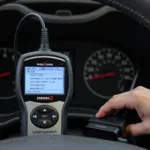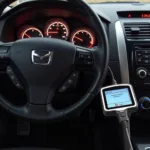Understanding your car’s inner workings can feel like cracking a complex code. But what if you could easily decipher those engine codes and understand exactly what’s going on? That’s where easy OBD2 scanners come in. These handy devices empower car owners to diagnose issues, potentially saving money and gaining valuable insights into their vehicle’s health, without needing to be a certified mechanic.
What is an OBD2 Scanner and Why Should You Use One?
An OBD2 (On-Board Diagnostics II) scanner is a tool that plugs into your car’s OBD2 port, typically located under the steering wheel. This port serves as a central hub for your car’s data, collecting information about engine performance, emissions, and various other systems. An easy OBD2 scanner accesses this data, reads Diagnostic Trouble Codes (DTCs), and presents them in an understandable format, often through a smartphone or tablet app.
Think of your car as communicating in a complex language. When something goes wrong, it tries to alert you, but it uses cryptic codes. An OBD2 scanner acts as a translator, converting those codes into plain English descriptions like “faulty oxygen sensor” or “loose fuel cap.” This knowledge allows you to address minor problems before they become major, and costly, repairs.
Key Benefits of Using an Easy OBD2 Scanner
- Save Money on Repairs: By identifying car troubles yourself, you can avoid unnecessary trips to the mechanic for a simple check engine light diagnosis. Knowing the problem upfront can also help you negotiate repair costs more effectively.
- Empowerment Through Knowledge: Understanding your car’s condition puts you in control. You can make informed decisions about repairs, maintenance, and overall vehicle care.
- Proactive Maintenance and Peace of Mind: Regular scans with an OBD2 scanner can provide peace of mind, ensuring your car is running optimally and safely. Identifying potential issues early allows for preventative maintenance, potentially extending the life of your vehicle.
- Increased Transparency with Mechanics: An OBD2 scanner gives you transparency into your car’s condition, preventing you from being misled or overcharged by unscrupulous mechanics. You can confirm their diagnoses and understand the necessary repairs.
Choosing the Best OBD2 Scanner for Your Needs
Not all OBD2 scanners are created equal; some are more sophisticated than others. Consider these factors when selecting the right one for your situation:
- Vehicle Compatibility is Key: Ensure the scanner is compatible with your car’s make, model, and year. Most OBD2 scanners are designed to work with vehicles manufactured after 1996, but it’s always best to verify.
- Features: Basic vs. Advanced: Some scanners offer basic code reading, while others provide advanced features like live data streaming (allowing you to monitor sensor readings in real-time), emissions readiness testing, freeze frame data (capturing data when a fault occurred), and even specialized features like ABS or SRS diagnostics.
- User-Friendly App Interface: Opt for a scanner with an intuitive and easy-to-navigate app interface. Look for clear code definitions, helpful repair information, and user-friendly data displays.
- Customer Reviews and Ratings: Research online reviews and ratings to assess the scanner’s accuracy, reliability, ease of use, and overall customer satisfaction. Pay attention to feedback regarding connectivity issues, app performance, and customer support.
How to Use Your OBD2 Scanner: A Step-by-Step Guide
Using an OBD2 scanner is usually a straightforward process:
- Locate the OBD2 Port: Find your car’s OBD2 port. It’s typically located under the dashboard on the driver’s side, but consult your car’s manual if you’re unsure.
- Connect the Scanner: Plug the OBD2 scanner into the port. You should hear a click when it’s securely connected.
- Turn on the Ignition (But Don’t Start the Engine): Turn the ignition key to the “on” position, but don’t start the engine. This provides power to the car’s computer.
- Launch the Scanner App: Download and install the app associated with your scanner on your smartphone or tablet.
- Pair the Scanner with Your Device: Connect your smartphone or tablet to the scanner, typically via Bluetooth. Follow the app’s instructions for pairing.
- Read the Diagnostic Trouble Codes: The app will display any stored or pending DTCs (Diagnostic Trouble Codes).
- Research the Codes and Symptoms: Use online resources, the app’s built-in database, or a trusted mechanic to understand what each code means and potential causes. Pay attention to any symptoms your car is exhibiting.
- Clear the Codes (After Addressing the Issue): Once you’ve addressed the underlying problem, use the app to clear the codes from your car’s computer. Note: clearing codes without fixing the problem will only result in the codes returning.
OBD2 Scanners: Your Path to Automotive Confidence
Taking control of your car’s health doesn’t require advanced mechanical knowledge. Easy OBD2 scanners empower you with the ability to diagnose problems, understand your car’s performance, and make informed decisions about its care. With this knowledge, you can keep your vehicle running smoothly, safely, and efficiently for years to come.
Frequently Asked Questions
Q: Will an OBD2 scanner work on my specific car model?
A: Most OBD2 scanners are compatible with vehicles manufactured after 1996 in the United States (and similar regulations in other countries). However, it’s crucial to verify the scanner’s compatibility with your specific car’s make, model, and year before purchasing. Check the scanner’s product description or the manufacturer’s website for compatibility information.
Q: After using an OBD2 scanner, can I fix any problem myself?
A: While an OBD2 scanner can help you pinpoint the problem, remember that it’s just a diagnostic tool. Some issues may require professional mechanical expertise, specialized tools, or specific knowledge. If you’re not comfortable performing the repairs yourself, consult a qualified mechanic.
Q: How frequently should I use my OBD2 scanner to check for problems?
A: It’s a good practice to scan your car for codes monthly or before embarking on long trips. Regular checks can help you identify potential problems early, preventing them from escalating into more serious and costly issues. Additionally, scan your car whenever the check engine light illuminates.
Need Expert Assistance?
For personalized support with OBD2 scanners and car diagnostics, our team of experienced professionals is here to help. Contact us via WhatsApp: +1(641)206-8880 or send us an email at [email protected]. We’re available 24/7 to address your inquiries and guide you toward the optimal solutions for your car care needs.


